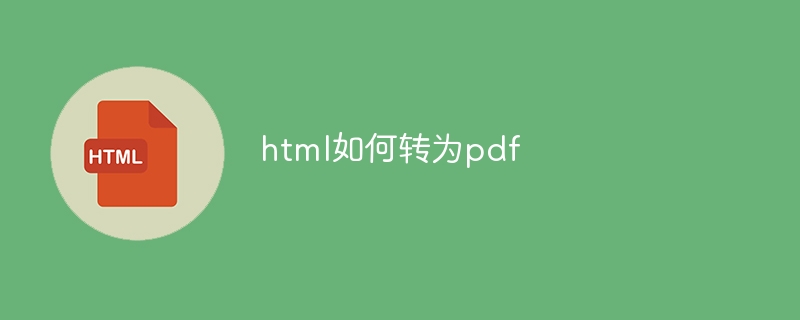How to convert html to pdf
You can convert HTML to PDF by following these steps: Choose a converter (such as Adobe Acrobat Reader, Google Chrome, Microsoft Edge). Load an HTML document (via file picker, drag-and-drop, or enter URL). Custom settings (optional, such as page size, margins). Start the conversion. Download the converted PDF.

How to convert HTML to PDF
Step 1: Choose a converter
There are many online and desktop converters that can convert HTML to PDF. Some popular options include:
- Adobe Acrobat Reader
- Google Chrome
- Microsoft Edge
- Zamzar
- PDF24 Tools
Step 2: Load the HTML document
In the converter of your choice, load the HTML document you want to convert to PDF. You can do this by:
- Using the file selector: Browse and select the HTML file.
- Drag and drop: Drag and drop HTML files into the converter window.
- Enter URL: For the online converter, enter the URL of the HTML document.
Step 3: Custom settings (optional)
Most converters provide some custom settings, such as:
- Page Size and Orientation
- Margins
- Header and Footer
- Background Color
Adjust these settings as needed.
Step 4: Start the conversion
Click the Convert button to start the conversion process. This may take some time, depending on the size and complexity of the HTML document.
Step 5: Download PDF
After the conversion is completed, you will be able to download the converted PDF file. The file will be saved in the folder you specify, or the online converter will provide a download link.
Tip:
- Make sure the HTML document is well-formatted and error-free.
- Preview the PDF before converting to make sure it meets your requirements.
- Some converters may require payment to access advanced features.
The above is the detailed content of How to convert html to pdf. For more information, please follow other related articles on the PHP Chinese website!

Hot AI Tools

Undresser.AI Undress
AI-powered app for creating realistic nude photos

AI Clothes Remover
Online AI tool for removing clothes from photos.

Undress AI Tool
Undress images for free

Clothoff.io
AI clothes remover

AI Hentai Generator
Generate AI Hentai for free.

Hot Article

Hot Tools

Notepad++7.3.1
Easy-to-use and free code editor

SublimeText3 Chinese version
Chinese version, very easy to use

Zend Studio 13.0.1
Powerful PHP integrated development environment

Dreamweaver CS6
Visual web development tools

SublimeText3 Mac version
God-level code editing software (SublimeText3)

Hot Topics
 1376
1376
 52
52
 What is the purpose of the <progress> element?
Mar 21, 2025 pm 12:34 PM
What is the purpose of the <progress> element?
Mar 21, 2025 pm 12:34 PM
The article discusses the HTML <progress> element, its purpose, styling, and differences from the <meter> element. The main focus is on using <progress> for task completion and <meter> for stati
 What is the purpose of the <datalist> element?
Mar 21, 2025 pm 12:33 PM
What is the purpose of the <datalist> element?
Mar 21, 2025 pm 12:33 PM
The article discusses the HTML <datalist> element, which enhances forms by providing autocomplete suggestions, improving user experience and reducing errors.Character count: 159
 What are the best practices for cross-browser compatibility in HTML5?
Mar 17, 2025 pm 12:20 PM
What are the best practices for cross-browser compatibility in HTML5?
Mar 17, 2025 pm 12:20 PM
Article discusses best practices for ensuring HTML5 cross-browser compatibility, focusing on feature detection, progressive enhancement, and testing methods.
 What is the purpose of the <meter> element?
Mar 21, 2025 pm 12:35 PM
What is the purpose of the <meter> element?
Mar 21, 2025 pm 12:35 PM
The article discusses the HTML <meter> element, used for displaying scalar or fractional values within a range, and its common applications in web development. It differentiates <meter> from <progress> and ex
 How do I use the HTML5 <time> element to represent dates and times semantically?
Mar 12, 2025 pm 04:05 PM
How do I use the HTML5 <time> element to represent dates and times semantically?
Mar 12, 2025 pm 04:05 PM
This article explains the HTML5 <time> element for semantic date/time representation. It emphasizes the importance of the datetime attribute for machine readability (ISO 8601 format) alongside human-readable text, boosting accessibilit
 How do I use HTML5 form validation attributes to validate user input?
Mar 17, 2025 pm 12:27 PM
How do I use HTML5 form validation attributes to validate user input?
Mar 17, 2025 pm 12:27 PM
The article discusses using HTML5 form validation attributes like required, pattern, min, max, and length limits to validate user input directly in the browser.
 What is the viewport meta tag? Why is it important for responsive design?
Mar 20, 2025 pm 05:56 PM
What is the viewport meta tag? Why is it important for responsive design?
Mar 20, 2025 pm 05:56 PM
The article discusses the viewport meta tag, essential for responsive web design on mobile devices. It explains how proper use ensures optimal content scaling and user interaction, while misuse can lead to design and accessibility issues.
 What is the purpose of the <iframe> tag? What are the security considerations when using it?
Mar 20, 2025 pm 06:05 PM
What is the purpose of the <iframe> tag? What are the security considerations when using it?
Mar 20, 2025 pm 06:05 PM
The article discusses the <iframe> tag's purpose in embedding external content into webpages, its common uses, security risks, and alternatives like object tags and APIs.




